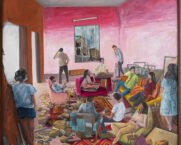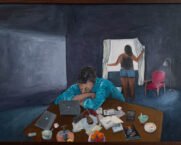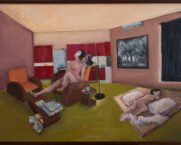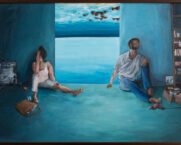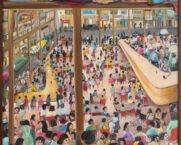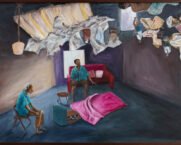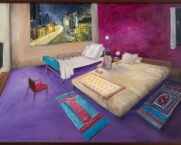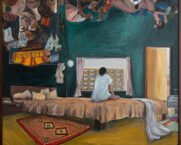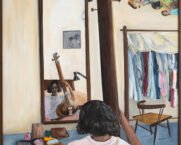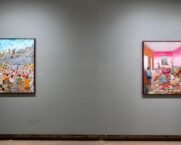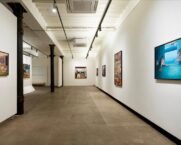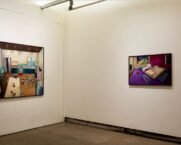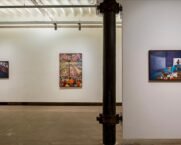C&L Shows
Nityan Unnikrishnan: Man in the Middle
Nityan Unnikrishnan
2024
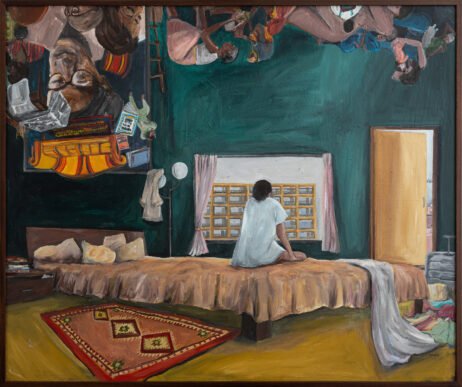
Overview
LIGHT IS NOT THE SOURCE OF THE WINDOW
Where does ‘Man in the Middle’ stand vis-à-vis Nityan Unnikrishnan’s earlier work? There’s less carnage, more breakage. Less apocalyptic howl, more eerie silence.
In 2020, Nityan made a painting of a bedroom: the woman tangled asleep in the sheets, the man perched at the edge of the bed in a brown study of what looks like post-coital melancholia. On the walls of this room are two paintings: one a carnival of creatures in a multitude of contortions, the other a sober domestic scene in which a man (is it the same man?) sits at his desk, a woman at the edge of a sofa behind him, holding her head (is it a migraine attack or just everyday despair?). Paintings within paintings on the walls of the house in the painting titled, ‘The House Tilts’.
In Nityan’s new work—the house has tilted.
It’s as if the mind has no room for separations anymore so everything comes crowding in—downside up.
It’s as if a tremendous hurricane has swept stricken parents and skeletal lovers, demon-slayers and splayed-out sleepers, toys and chairs and clandestine weepers into the space where a girl plays the tanpura with her eyes closed.
She is the eye of the silent storm, turning her back on we who shall not sleep tonight for we have seen the whirlwind exist simultaneously with calm.
The painting I’m looking at is ‘The Other Room’ (2024). The girl is leaving. All her bags are packed, with the neatness of an obsessive keeping a secret—now split wide open—disorder at bay. She’s ready to go where the traces of her other lives may or may not catch up with her.
There is another music in that room—you must see it to hear it.
Other stories you must fall for, hook, line and sinker, other illusions including where a man’s place might be.
Nityan isn’t ‘invoking’ Annie Ernaux, Carl Hiaasen, Warren Zevon. He is simply scattering pods: burst them open to know what our lives might be composed (recomposed) from.
*
To compose: the picture, the music, oneself.
Composure is what Nityan’s figures hold—at a terrific price.
You see it in the lines of the solitary woman sitting on the bed in a room where more than ‘Light Comes In’.
How do we know where this painting ends and another begins?
There is a ladder that leans against a line that hints at the impossibility of separation.
Labourers bend their tired bodies over stones, mothers over their babies, a giant paternal face disturbs the autonomy of the sofa, an object both pathetic and portentous like so many of the things that litter our living rooms.
All of this hovers, gravity-defiant.
Sweep, Nityan says, the minefields.
Calm down. Be calm. Becalmed.
*
Grief inhabits the rooms of Nityan’s house in the spy of love.
In that world, the light is not the source of the window.
The chaos that lives inside us finds its mirror, repeatedly.
Between the newspaper and the swirling sheet, the shroud.
Widows hover at the edge of a story told ‘In Third Person’.
Have those boys grown into men since they stepped off the precipice of attention?
Inward and away they look, under another billowing gale.
Stormlight, then, is Nityan’s source of illumination.
Hemmed in by hauntings, human figures cohabit terror and isolation in colours that insist on singing.
Synaesthesia is not a dirty word in Nityan’s world.
Exhaustion is.
If you have ever been overwhelmed enough to black out the windows and let the sea in through the fourth wall, you know that feeling.
Separation is anxiety, and to turn one’s back on the outside is the beginning of another kind of end.
Nityan’s people turn their backs on us, only so we can see what they see.
And what they see is the rampaging bulldozer, the blaze of hate. ‘Enjoy the View’ the killer-cop says, off-screen.
And they do. Spectators in a danse macabre exult in the death of the other.
In other words, Nityan is not drawing the curtains on the world.
It is curtains for the world as we once knew it, yes, but… it isn’t curtains for us—if we can bear to keep looking.
Take a look at the painting titled ‘Frankfurt School’.
I ask you the question I asked myself:
What does this devastated drawing room have to do with a group of researchers associated with the Institute for Social Research founded in 1923 by Carl Grünberg as an adjunct to the University of Frankfurt?
Halt. Look it up [down]
The Frankfurt School of theorists, which figured the likes of
T.W. Adorno, Erich Fromm, Herbert Marcuse, and Walter
Benjamin, applied Marxism to a radical interdisciplinary social
theory. Insights from psychoanalysis,
sociology, existential philosophy, and other disciplines were
used to analyse social relations within capitalist economic
systems. This approach, which came to be known as ‘critical
theory’, yielded influential critiques of large corporations and
monopolies, the role of technology, the industrialisation
of culture, and the decline of the individual within capitalist
society. Fascism and authoritarianism were also prominent
subjects of their study. When Hitler came to power in 1933
many of the scholars, including Bejamin, fled to the States. By
the 50s, the proponents of the Frankfurt School (now back in
the heimat) were shooting in different directions. While many
debunked orthodox Marxism, a deeply critical stance against
capitalism remained.
Now return to the site of the painting.
Are these armchair revolutionaries, discoursing on the state of the world as it kabooms around and amidst them? Is it a huddle of friends, gathered around their certitudes? Is this their last hurrah, their ‘deeply critical stance’? Last bastion of hope, or lost and laughable joke?
Nityan invites speculation. And demands attention.
Look closely, for here too, amidst the explosion, is calm.
Here too, are women with their backs to us.
Two women—not bystanders so much as sentinels—a watchful tension in their stance.
Two men pace the far end of the room, each on a mobile phone, consumed by the call.
The wall on the left is broken, and no, it isn’t a metaphor.
Nityan is telling us something specific, as real as the reality we reel under, from afar.
Perhaps the knife that stabbed Rushdie in the eye is the one we shall pare the truth with.
Perhaps Umar Khalid’s upraised fist will break through the confinement of his cry.
Perhaps the great hive of the Gig will kill all the worker bees, gathered in splendid desolation.
There will always be too much information and too little time.
Perhaps the last forest will be the one we shall hang in black and white on a wasted wall.
*
Nityan’s paintings made me want to stand on my head to see better.
What he stands on its head is the idea of a fixed way of seeing.
Could upside-down be the right way in?
Up. Down. Fragile?
His paintings led me to that Jacques Rivette place in my head that said: Here is the strangest kinship.
Paranoia. Absurdity. Survival?
Rivette showed us that conspiracy was the only theory that lasts. He adored layered narratives, the unsettlement of space-time-sense so beautifully wafted into his long unhurried films.
In Nityan’s work, I feel that waft.
In his world, ‘together’ and ‘alone’ may rhyme, as long as there is someone who confesses, while there is still time, ‘All I think of is growing old with you’.
To see ‘Man in the Middle’ better, we must levitate.
Be watchful, for there it comes, in through the out door—the zeppelin of pain.
~ Sampurna Chattarji
November 2024
A video walkthrough by Mortimer Chatterjee
- Works
- Install Views

